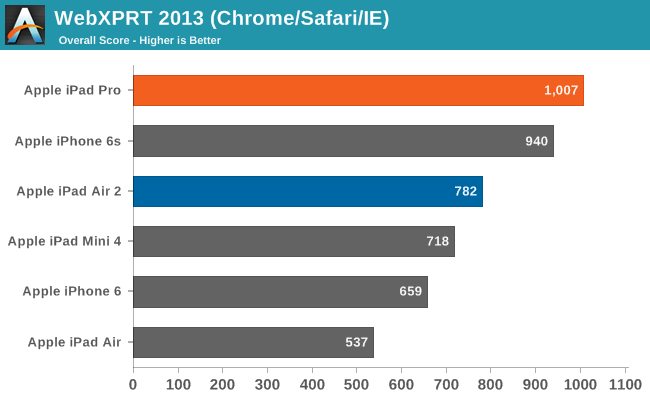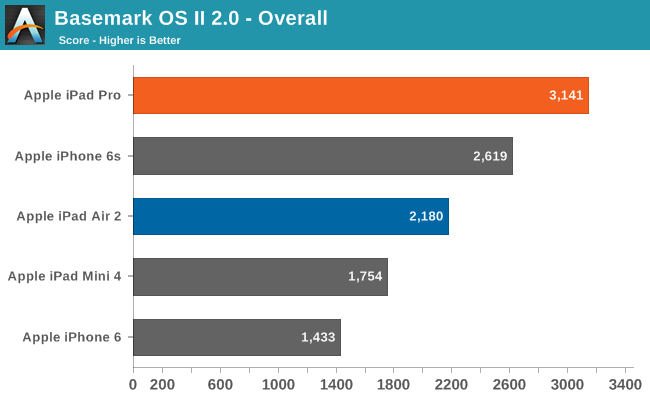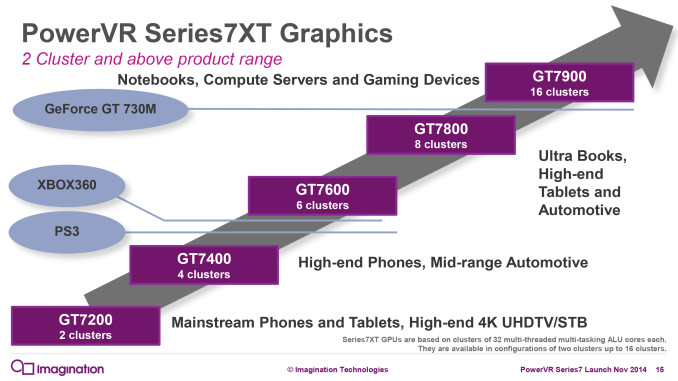The iPad Pro Preview: Taking Notes With iPad Pro
by Joshua Ho & Ryan Smith on November 11, 2015 7:00 AM ESTThe A9X SoC & More To Come
Finally, as everyone is undoubtedly eagerly anticipating our look at the A9X SoC inside the iPad Pro, let’s take a very quick look at what we know about the SoC so far. There’s a bit of a limit to what we can do blindly via just software, but I’m hoping that the eventual A9X die shots will confirm some of our suspicions on A9X’s configuration.
| Apple SoC Comparison | ||||||
| A9X | A9 | A8X | A6X | |||
| CPU | 2x Twister | 2x Twister | 3x Typhoon | 2x Swift | ||
| CPU Clockspeed | 2.26GHz | 1.85GHz | 1.5GHz | 1.3GHz | ||
| GPU | PVR 10 cluster Series7? | PVR GT7600 | Apple/PVR GXA6850 | PVR SGX554 MP4 | ||
| RAM | 4GB LPDDR4 | 2GB LPDDR4 | 2GB LPDDR3 | 1GB LPDDR2 | ||
| Memory Bus Width | 128-bit | 64-bit | 128-bit | 128-bit | ||
| Memory Bandwidth | 51.2GB/sec | 25.6GB/sec | 25.6GB/sec | 17.1GB/sec | ||
| L2 Cache | 3MB | 3MB | 2MB | 1MB | ||
| Manufacturing Process | Unknown (TSMC 16nm or Samsung 14nm) |
TSMC 16nm & Samsung 14nm |
TSMC 20nm | Samsung 32nm | ||
First and foremost, the most unexpected news here is that unlike A8X, A9X is not packing a triple-core CPU. Instead A9X drops back down to just a pair of Twister CPU cores. The twist here is that relative to A8X and A9, Apple has cranked up their CPU clockspeeds. Way, way up. Whereas the iPad Air 2 (A8X) shipped at 1.5GHz and the iPhone 6s (A9) at 1.85GHz, the A9X sees Apple push their clockspeed to 2.26GHz. Not counting the architectural changes, this is 22% higher clocked than the A9 and 51% higher than the A8X.
The fact that Apple dropped back down to 2 CPU cores is unexpected given that we don’t expect Apple to ever go backwards in such a fashion, and while we’ll never know the official reason for everything Apple does, in retrospect I’m starting to think that A8X was an anomaly and Apple didn’t really want a tri-core CPU in the first place. A8X came at a time where Apple was bound by TSMC’s 20nm process and couldn’t drive up their clockspeeds without vastly increasing power consumption, so a third core was a far more power effective option.


By comparison, with the FinFET process Apple is using here – and given the lower volume of A9X I don’t have reason to believe it’s dual-sourced, so it’s either TSMC or Samsung – Apple has been free to increase their clockspeeds substantially. At the same time these FinFET processes are still new and yields won’t be great, so there is a strong incentive to keep die sizes down to keep yields up, and adding a third core would only make that harder. If I had to guess, Apple only wanted two cores to begin with – this makes it easier for developers knowing that they only have two cores to work with – and that it’s A8X that is the anomaly.
Otherwise a highly clocked CPU is far more in-line with Apple’s design philosophy as it means that A9X is capable of amazing single-threaded performance – and keep in mind that we’re talking ARM Cortex-A57-like clockspeeds for a CPU that gets much more work done per cycle – so what we see here makes a lot of sense. Plus with iPad Pro in particular Apple has more battery capacity to sustain the power draw of a higher clocked SoC, and more surface area to dissipate that heat, so the usual concerns about power and cooling aren’t quite as pressing. I do wonder if this will impact multitasking performance much, but given what Twister is capable of, I’m not nearly ready to write off a dual-core Twister implementation clocked this high.
Moving on, as is customary for the X-series SoCs from Apple, A9X features what I believe to be a wider 128-bit LPDDR4 memory bus. The memory bandwidth numbers clearly point to a wider bus, and Apple needs the bandwidth to feed a more powerful GPU.
| Geekbench 3 Memory Bandwidth Comparison (1 thread) | ||||||
| Stream Copy | Stream Scale | Stream Add | Stream Triad | |||
| Apple A9X 2.26GHz | 20.8 GB/s | 15.0 GB/s | 15.3 GB/s | 15.1 GB/s | ||
| Apple A8X 1.5GHz | 14.2 GB/s | 7.44 GB/s | 7.54 GB/s | 7.49 GB/s | ||
| A9X Advantage | 46.4% | 101% | 103% | 102% | ||
Which brings us to the last bit of our preview, the GPU. Apple went with a 6 cluster PowerVR Series7 design on A9, and for A9X they have gone with a larger design. Without a die photo it’s basically impossible to determine how many clusters are in use since clockspeed plays such an important role. What we do know is that GPU performance relative to A9 has pretty much doubled, which once again is right in-line with Apple’s usual design goals.

Given what Apple has done with clockspeed on Twister, for the moment I am staking my bet on it being a 10 cluster design with a higher GPU clockspeed than A9 giving us the rest of the performance boost. To be clear here this could also be a 12 cluster design at a similar clockspeed or even an 8 cluster design clocked far higher – we’ll need die shots to confirm – but given all of the options it’s a 10 cluster design that is the best balance between die size and clockspeed, and it would also be the biggest curveball Apple could throw. It should also be noted that PowerVR Series7 certainly supports such a configuration since it’s scalable from 2 to 16 clusters, although in Imagination’s official product catalog they don’t have a name for such a configuration. So for the moment I’m simply calling it a 10 cluster Series7.
Anyhow, we’ll be back later with a full review of the iPad Pro, including the pros and cons of Apple’s first large-format, productivity-oriented tablet, and a full breakdown of the A9X SoC. So until then stay tuned.











199 Comments
View All Comments
tipoo - Wednesday, November 11, 2015 - link
I'm curious as well. For a while with ARM there were lots of easy pickings to be had as it's performance was way behind x86, but as process nodes shrunk and they were able to add more and more they were able to catch up to an impressive degree, even trading blows with Core M.I wonder how much longer Apple can pull these gains out of their hat, or if they're going to hit the wall Intel did and just give us 10-25% improvements each year, more like the 5S-6 than the 6-6S.
linkgr - Thursday, November 12, 2015 - link
Maybe then they will start to introduce 4 core designs to their products.A 4 core a9x design on a laptop form factor, with perhaps active cooling and a higher tpd could probably be faster than most of the Intel SoCs by a margin with tasks that use multiple cores.
I think the real question here is how they compare cost wise.
If the arm soc is cheaper, in a meaningful way, then the only real question is when, not why, we will see them in our laptops.
lucam - Wednesday, November 11, 2015 - link
It's always a mystery knowing which GPU Apple exactly uses. And it is more mysterious why only Apple uses high specs Powervr GPU...Ryan do you have an answer for that? :)
malcolmz07 - Wednesday, November 11, 2015 - link
I think the answer is : the price , it's like the iris in the laptop , very few OEM uses it because of the pricelucam - Wednesday, November 11, 2015 - link
Maybe....but Imagination has a various list of PowerVr Gpus nowadays...all series 6xt and series 7xt...can't believe that Android market stuck with G6200 or G6430 (basically the same of the iPhone 5s..Ipad Air...almost A 3 years ago GPU...)...:(Ryan Smith - Wednesday, November 11, 2015 - link
An answer for why Apple uses PowerVR GPUs? That's a million dollar question I'm sure that ARM asks themselves every year. From the outside it's hard to say anything for sure. Certainly momentum plays a part, and there's nothing to indicate that Apple and Imagination have anything less than a solid working relationship. Apple's technical criteria is a greater mystery, though between the options of rolling their own GPU, using Mali, and using PowerVR, clearly they find PowerVR to be the best choice.lucam - Wednesday, November 11, 2015 - link
Hi Ryan, thanks for that.My question was more why only Apple uses high specs PowerVr by the way. The best you can get in the Android market is the G6430 at this stage...an almost 3 years old GPU.
My guess is that Apple has some sort of exclusive use of Imagination GPUs...but who really knows..
tipoo - Wednesday, November 11, 2015 - link
I don't think it's that, I think it's the same reason why Apple is the only one spending die size on an 8MB l3 in the A9. They know what their total product margins will be, they know they'll sell in the millions, so they can afford to be more risky with die size since it's barely any risk to them at all.Android players are working off lower margins, and lower sales per model to boot. Samsung did pretty good with the GS6 Exynos, but other than them, everyone is going for smaller SoC dies.
lucam - Wednesday, November 11, 2015 - link
True. I can accept that.Anyway Samsung in their previous Exynos used to have PowerVr GPUs as well. Now they use only Mali (high specs of it).
I believe losing Samsung as client was a big loss for Imagination...
lilo777 - Wednesday, November 11, 2015 - link
I think the answer is quite simple. I believe the leading SOC manufacturers for Android devices (Samsung and Qualcomm) do not use PowerVR period. So the question why nobody (but Apple) uses high spec PowerVR is kind of irrelevant. And if I remember correctly PowerVR produces good results but Mali and Adreno are not bad too. Very often iDevices have advantage in on-screen benchmarks only because they have lower resolution. Then of course Anantech reviews of Apple devices are always special with rather peculiar selection of benchmarks emphasizing the strong features of Apple SOCs. For example, multi-core performance is always de-emphasized even though in most cases when performance really matters (gaming, image processing etc.) the algorithms are perfectly multi-threadable and single core performance is becoming less and less relevant (browsing is probably the last hold-out).BTW, did you notice that AT now are getting iDevies directly from Apple for early reviews? This was not the case before. Couple of years of glowing iDevice reviews and voilà...